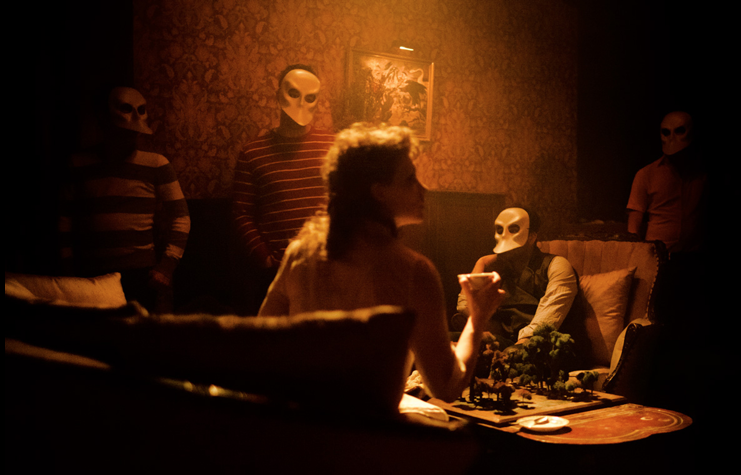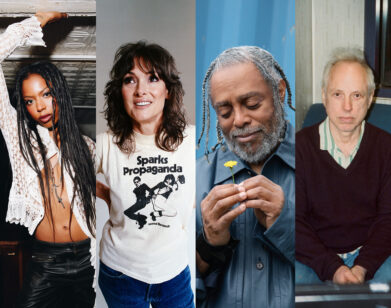Art Not Without Ambition: Sleep No More’s Maxine Doyle

A SCENE FROM SLEEP NO MORE (THOSE IN MASKS ARE THE AUDIENCE MEMBERS).
PHOTO COURTESY OF ALICK CROSSLEY
Tucked deep into an unremarkable block on West 27th Street sits the McKittrick Hotel. Completed in 1939 and designed to be the most luxurious hotel in New York, it was condemned and shuttered two days after the beginning of World War II. The McKittrick is a beautiful, haunting space; and it’s perfect for the project that’s reopened it, 72 years later.
Sleep No More, a production of the Emursive and Punchdrunk theater companies, is a dramatic experience unlike any other in the city. It’s a site-specific interpretation of Macbeth (with some Hitchcock Rebecca thrown in for good measure) that fills every nook and cranny of the hotel’s six stories with evocative, intricately detailed sets—a mental ward, a cemetery, a ’30s-style hotel, that fateful banquet hall. Audiences are encouraged to rifle through drawers, open cabinets, and fully immerse themselves in the reality of the show—and to follow the performers, who act out themes and scenes from the play in balletic, intensely physical style.
The choreography is the work of Maxine Doyle, who with Felix Barrett directed the show, which took up residence in the McKittrick after a successful run in Brookline, Massachusetts. Doyle’s keeping busy—Punchdrunk is opening a show for children at the Manchester International Festival at the end of July, and another show for adults in London later on—but she found time to chat from home in the UK.
ALEXANDRIA SYMONDS: Sleep No More is such a completely different experience than any other theater I’ve seen in New York. What would you say your main role has been?
MAXINE DOYLE: I started working with the company eight years ago, when Felix was looking for a choreographer … [In this show] we started to bring a real sort of physical, visual, performance language, to take the characters and the structures and the relationships and situations of Macbeth and create a physical language for that, which works very much in collaboration with the space and the design. I worked very closely with the performers and the cast, to create this kind of athletic and sometimes extreme, sometimes really emotionally driven choreography.
SYMONDS: In terms of the production design, where was everything sourced? Have you started anew with each new space, or have you taken a lot of stuff with you?
DOYLE: We have Felix, and then there’s two other designers, Beatrice Minns and Livi Vaughan, they’re associate designers. There’s that team, and then there’s a whole group of volunteer designers. Part of their job in the States, in New York, was actually to go shopping, kind of far afield, to all those amazing fairs that there are in the States. So, all of the stuff for this show—some of it we kept from Boston, we shipped over from Boston, but lots of the bits of the detail and the furniture was from New York and upstate.
SYMONDS: It seemed like a lot of it was created from scratch, too—the volumes and volumes of loose papers that are on desks, and things like that that are very specific to the show. How long did it take to make all that, and who did it?
DOYLE: Beatrice Minns, her brilliance is in the details, and in our work, the devil is in the details. So again, Bea, with her team of volunteers sparked that process—I’m not sure exactly how long it took. From day one, really, they were writing letters, scribbling notes, copying pages of text, collecting samples of hair, building salt piles. Finding minute details.
SYMONDS: It’s such a huge volume of detail.
DOYLE: Everything you touch is real, and you should be able open the door and discover. If you’re a kind of Shakespearean scholar, then you should be able to really plumb the depths of our interrogation into the play and its context. And if you’re not interested in Shakespeare at all, you’ll still be able to uncover some delights and find things that will unsettle you or stimulate your curiosity.
SYMONDS: I didn’t see any of the performers speaking. It was a much more physical performance than people will expect. How did you start adapting it?
DOYLE: I’m a choreographer and a director, and my main job is to find the physical—to find the movement language. You know, the body is what interests me, much more than words do. I find that the body often can be more expressive than language—certainly in our world, where you need to be able to convey the essence of a scene very quickly. It’s about really appreciating and analyzing the text, and reducing it to very clear and attainable ideas, and then working with the performers, who get to do a kind of improvisation to create the choreography. All of the movement is essentially there to drive the story. Or to show this performer, the character, in an authentic emotional space. You stumble across Lady Macbeth in her dressing room, in a kind of sleepwalking state. This isn’t a literal playing-out; it’s like a fast-track through the body.
SYMONDS: When you think about theater in general, I think it’s often thought of as a very community-driven art form—a bunch of people get together at a certain specific time, when a certain specific performance will be given, and everyone has the same experience. But it seems like what you’re going for with Sleep No More is a show where every person who goes to see your show will have experienced something completely different. How do you balance the idea of a community event with individual experience?
DOYLE: Yeah, I’m really attentive to both elements, and I think one of my challenges, in the work, is to offer lots of options. The work is really dense, there’s lots of story, lots of characters to follow, a huge space—in order that the audience can, if they really want to, do this individual journey through different things at different moments. There’s also a strong sense of ensemble in the piece. There are these kind of ensemble moments: the Macbeth party when Duncan arrives at the castle, which pulls the majority of the cast together, which can bring the audience together, for a kind of shared moment. There’s the banquet scene, when Banquo’s ghost appears and we see the breakdown of Macbeth and Lady Macbeth. And it’s to draw the audience back to a shared, communal space. And then ultimately there’s the finale, when we see the end of the play. Which calls everyone again into that same space. There’s something incredibly powerful about the shared experience of theater. I think what we’re interested in is the possibility to combine a really individual experience with a shared experience. And afterwards, the process of sharing what has happened to you and where you’ve been and what you’ve done and what you’ve seen, we like that we’re engaging that kind of dialogue.
SYMONDS: As the choreographer, is there any specific moment that you’re especially fond of, and you’re sad to know that not everyone will see it? I spent a lot of time on the hotel floor, and the pas de deux with Lady MacDuff was so beautiful. Thinking that there were a hundred other people on different floors, not seeing it, kind of made me sad.
DOYLE: Oh, that’s difficult, isn’t it? I just hope that there’s lots of really lovely, interesting or challenging and dramatic material for people to kind of encounter. And, I mean, dancing isn’t everyone’s cup of tea. Something I, maybe, feel excited by or proud of, the audience might leave halfway through. You really have to relinquish that: you make the work, and it’s just for you as an artist, and you have to hand it over to the audience and trust that they’ll go with their own intention.
SYMONDS: Have you been through the show with regular audiences?
DOYLE: Yeah, when I’m in the States, I have. Actually, when a show opens, when it’s in previews, I’m actually watching the audience, for the first two weeks, more than the performers. I’m looking at their movements, and how they shift as a pack, and how they work as individuals. Because often in those first few weeks, when we get the audience into the space, we really learn how the show is working. And I might make quite a few changes in the choreography as a result of that.
SYMONDS: Do they behave pretty much as you expect them to, or are there surprises when you watch an audience watch a show?
DOYLE: In the beginning, audiences are confused, and then they’re curious, and by the middle of a show, they become more eager. By the end they’re very hungry. You see an audience that will gain confidence and really begin to trust their instincts—to either stay in a space, to go against the crowd, or to vigorously follow a character. People have a kind of respectful attention to the work. That said, I have witnessed some members of the audience who get a bit carried away or just push the boundaries. It can become a little duel between the performer and the audience.
SLEEP NO MORE PLAYS THROUGH SEPTEMBER 5 AT THE MCKITTRICK HOTEL, 530 WEST 27TH STREET, NEW YORK. FOR TICKETS AND MORE INFORMATION, VISIT THE SHOW’S WEBSITE.






